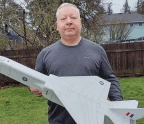BUILD STRAIGHT, FLY STRAIGHT!

t’s always interesting to see the diverse interests of those involved in building and flying giant-scale aircraft. Some RC’ers are involved completely in aerobatics, others focus on building exact replicas of full-size subjects, and some enjoy pushing the envelope with turbine-powered jets. No matter what the interest of the pilot and/or builder is, care and caution must be taken when building all model airplanes. Aside from proper building material selection and making structurally sound glue joints, it is equally important to have a straight airframe for an airplane that will not only be enjoyable to fly, but will also stand the test of time. Having a straight airplane is a great benefit, as no computer mix will completely compensate for a warped airframe. The straighter an airframe is, the more neutral it will be while flying. I can honestly say that I have had many airplanes that only required a few clicks of trim (with
You’re reading a preview, subscribe to read more.
Start your free 30 days



